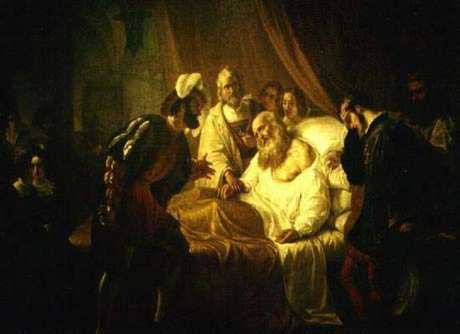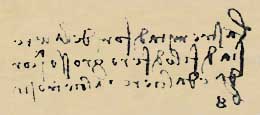

|
|
|
Leonardo da Vinci was born on April 15, 1452 in a stone farmhouse - which still stands today - in Anchiano, a small burg that lies about 3 km from Vinci. At the time of his birth, his father, Ser Piero, was 25 years old and worked as a notary public. Leonardo's mother was named Catarina, but that all that's known of her other than she was the daughter of a farmer, which is why Ser Piero never married her. He did however marry a different woman, Albierra di Giovanni Amadori, the same year Leonardo was born. His wife never had children, so Leonardo, though never legitimized, was their only child. At age 5 he moved in with his grandfather in Vinci, a small town in Tuscany. There he went to school and learned the 3 R's as well as
Latin. Displaying a certain talent, at 14 (1466), Leonardo was accepted into an apprenticeship under Andrea del Verrocchio in Florence (along with Botticelli, Perugino and Lorenzo di Credi). Verrocchio was a leading artist at the time working as a sculptor, painter, goldsmith and bronze caster. Verrochio was greatly impressed with Leonardo, but in 1472, at age 20, Leonardo's apprenticeship was over and his career began. This meant that he could contribute to the works produced by Verrocchio's shop. In 1476 Leonardo contributed to a picture of the Baptism of Christ by painting the kneeling angel and some of the background. Verrocchio was so awed by Leonardo's work that he supposedly said that he himself never wanted to touch a paintbrush again. This same year there was an odd situation. In Florence, it was customary for people to write out anonymous accusations and lace them in a wooden box which was in front of the Palazzo Vecchio. On April 8, 1476 someone accused Leonardo and four others of having a homosexual encounter with a 17 year old artist's model named Jacopo Saltarelli. He was accused twice - once in April, once in June. There were no witnesses. Leonardo's father refused to help, but his uncle petitioned for the intercession of Bernardo di Cortigiano, the head of the Florentine guilds. It was investigated and he and the others were acquitted based on the condition that they should never brought up again on similar charges. He had spent two months in prison. In 1477 Leonardo became independent. His first commission was to paint a scene about the Adoration of the Magi. He started but abandoned it in 1482 to work for Duke Ludovico Sforza of Milan - where he stayed for the next 18 years. In Milano he served as court artist and engineer. With abundant free time, he pursued his many interests: biology, mathematics, physics and human anatomy. He was supposedly the most accomplished lute player of his time and his personal lute was a of a style of his own invention. He was also known for his melodious voice.  The death of Leonardo
The death of LeonardoMilano fell to the French in 1499. Leonardo went to work in Mantua, Venice and Florence before returning to Milan in 1506 to work for the new French government until 1513. He then went to Rome with Giuliano de Medici, the brother of Pope Leo X. When de Medici died in March 1516, The French king, Francis I, invited Leonardo to the French court at Amboise. He took up residence in the Château Cloux. In 1517 he suffered a stroke which left his right side paralyzed, but still allowed him to produce drawings since he was left-handed. He died at on May 2, 1519, at age 67, after a brief illness. And though he was buried in the Church of St Florentine, during the Wars of Religion his remains were scattered.  Unless he was writing to someone, Leonardo wrote from right to left. He was also
demonstratively left-handed which was unusual since during those times of superstition, all children were forced to use their right hand. Why Leonardo wrote backward could be as innocent as to avoid the smearing that is common when left-handers move their hand over what they have already written or it could be as devious as to hide his secrets from prying eyes or to protect himself from charges of heresy by the Church.
Unless he was writing to someone, Leonardo wrote from right to left. He was also
demonstratively left-handed which was unusual since during those times of superstition, all children were forced to use their right hand. Why Leonardo wrote backward could be as innocent as to avoid the smearing that is common when left-handers move their hand over what they have already written or it could be as devious as to hide his secrets from prying eyes or to protect himself from charges of heresy by the Church.an example of Leonardo's right-to-left writing Although Leonard is most famous for his paintings of the Mona Lisa and The Last Supper, few artists have painted as little nor drawn as much. There are over 10,000 examples of his drawings that have survived, while very few of his painting have. Leonardo was an innovative and talented artist, but his interests and accomplishments extending into the areas of "anatomy, bridge building, flight, war machines, cartography, architecture, mathematics, geology, biology, natural history, music, philosophy, and even the telling of fables." (according to http://www.kfki.hu/~arthp/bio/l/leonardo/biograph.html ) From about 1489 Leonardo dissected a minimum of 19 cadavers. Not only did he make drawings, but he also built reconstructions with up to ten layers. He even constructed a glass model of the heart through which seeds in water or colored dyes could be pumped to observe and study the flow of blood. When he went to Rome with Giuliano de Medici, Leonardo designed and built many toys and machines to amuse and delight his patron. Among them was a machine that could turn copper metal into strips of uniform size. He also studied optics. He tried to make giant, rounded mirrors in his workshop quite similar to the mirrors used in modern telescopes. He also studied botany, and made a connection that the same patterns exist in many natural things - such the rings in a tree trunk resembling the ripples made by a stone dropped in water. He was hoping to prove that such natural repetitive patterns were evidence of universal natural laws.
the Renaissance Man. References: Leonardo da Vinci Online Learning About Leonardo Leonardo da Vinci - Biography Leonardo da Vinci WebMuseum: Leonardo da Vinci Leonardo da Vinci Museum Leonardo da Vinci: paleontologist Milan Science Museum - incredible! Web Gallery of Art |